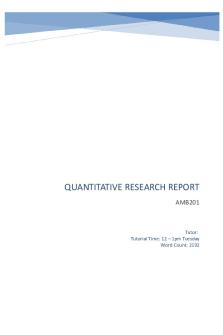Quantitative Plating&Pasteurization Lab Report PDF

| Title | Quantitative Plating&Pasteurization Lab Report |
|---|---|
| Author | Morgan Thiel |
| Course | General Microbiology |
| Institution | University of Wisconsin-Milwaukee |
| Pages | 3 |
| File Size | 82.2 KB |
| File Type | |
| Total Downloads | 6 |
| Total Views | 126 |
Summary
Download Quantitative Plating&Pasteurization Lab Report PDF
Description
Morgan Thiel
Quantitative Plating & Pasteurization PURPOSE: The purpose of this lab is to determine the number of colony forming units found within milk, before and after pasteurization. The number of colony forming units is relative based on the FDA’s food regulations and this lab determined if the pasteurization worked. PROCEDURE: We followed per the lab manual, with no deviations. RESULTS: Raw, Unpasteurized Milk Sample Dilution Number of Colony
10^-3 TNTC*
10^-4 TNTC*
10^-5 2125
10^-6 320
10^-7 38
Forming Units *TNTC= Too Numerous To Count Calculations per Undiluted Unpasteurized Milk Sample for Approximate Number of Colony forming Units per 1 ml: 10^-3: TNTC* 10^-4: TNTC* 10^-5: 2.125 x 10^8 10^-6: 3.2 x 10^8 10^-7: 3.8 x 10^8
Pasteurized Milk Sample 1
Morgan Thiel
Dilution Number of Colony
10^-3 1
10^-4 TFTC*
10^-5 TFTC*
10^-6 TFTC*
10^-7 TFTC*
Forming Units *TFTC= Too Few To Count Calculations per Undiluted Pasteurized Milk Sample for Approximate Number of Colony forming Units per 1 ml: 10^-3: 1 x 10^3 10^-4: TFTC* 10^-5: TFTC* 10^-6: TFTC* 10^-7: TFTC* DISCUSSION: Pasteurization is heat treating a liquid or food, after Pasteur’s experiments, which is utilized in treating milk to destroy harmful pathogens (Willey et. al. 14). Pasteurization limits the number of cells that are viable and able to replicate. This is important to ensure that the milk is safe to drink. Our expectations for this lab were to find that the pasteurized milk sample would be determined safe under FDA code, and that our raw milk sample would not be. We found that pasteurization of our given milk sample was in fact effective, as our results rendered the milk sample to have only 1 x 10^3 cells/ml, compared to the required
2
Morgan Thiel
limitations by the FDA, being 2 x 10^4 cells/ml. Our unpasteurized milk sample was not up to FDA regulation, as it carried 2.125 x 10^8 cells/ml, which is much larger amount compared to the FDA standard of 1 x 10^5 cells/ml for raw milk. Quantitative plating is when the original solution is diluted down increasingly and put on sterile plates. The dilutions make it a lot easier to calculate the amount of colony forming units per ml, as often there are too many to count. We only count plates ranging between 30 to 300 colony forming units range due to there being a too high number of colony forming units to count. This is also due to the inability to potentially distinguish individual colony forming unit’s verses ones that have been fused by contact between the cells. We then chose to utilize our lowest dilution that hits in range, being a dilution of 10^-5 for raw milk, and 10^-3 for pasteurized milk. CONCLUSION: Our results found that our sample of pasteurized milk was indeed up to the FDA safety standards, limiting to under 2 x 10^4 cells/ml, as we had only approximately 1 x 10^3 cells/ml. Our results for our raw milk sample were not up to code, as we had approximately 2.125 x 10^8 cells/ml on a 10^-5 dilution, as our smallest sample size, 10^-3 dilution, had too many forming colony forming units. Citations “Spontaneous Generation.” Prescott's Microbiology, by Willey et al., 10th ed., McGraw-Hill, 2017, p. 14.
3...
Similar Free PDFs

Quantitative Lab Report
- 20 Pages

Quantitative Report
- 14 Pages

Quantitative Report - Grade: 6
- 26 Pages

QUANTITATIVE ANALYSIS GROUP REPORT
- 28 Pages

LAB 5 - Lab report
- 4 Pages

Lab 8 - lab report
- 6 Pages

TLC Lab Lab Report
- 4 Pages

Lemonade Lab - Lab report
- 4 Pages

Post Lab - lab report
- 2 Pages

TLC lab - Lab report
- 3 Pages

Lab 8 - lab report
- 3 Pages

Lab 6 - Lab Report
- 6 Pages

Lab Report 5 - lab
- 5 Pages

Planaria lab - lab report
- 6 Pages
Popular Institutions
- Tinajero National High School - Annex
- Politeknik Caltex Riau
- Yokohama City University
- SGT University
- University of Al-Qadisiyah
- Divine Word College of Vigan
- Techniek College Rotterdam
- Universidade de Santiago
- Universiti Teknologi MARA Cawangan Johor Kampus Pasir Gudang
- Poltekkes Kemenkes Yogyakarta
- Baguio City National High School
- Colegio san marcos
- preparatoria uno
- Centro de Bachillerato Tecnológico Industrial y de Servicios No. 107
- Dalian Maritime University
- Quang Trung Secondary School
- Colegio Tecnológico en Informática
- Corporación Regional de Educación Superior
- Grupo CEDVA
- Dar Al Uloom University
- Centro de Estudios Preuniversitarios de la Universidad Nacional de Ingeniería
- 上智大学
- Aakash International School, Nuna Majara
- San Felipe Neri Catholic School
- Kang Chiao International School - New Taipei City
- Misamis Occidental National High School
- Institución Educativa Escuela Normal Juan Ladrilleros
- Kolehiyo ng Pantukan
- Batanes State College
- Instituto Continental
- Sekolah Menengah Kejuruan Kesehatan Kaltara (Tarakan)
- Colegio de La Inmaculada Concepcion - Cebu

